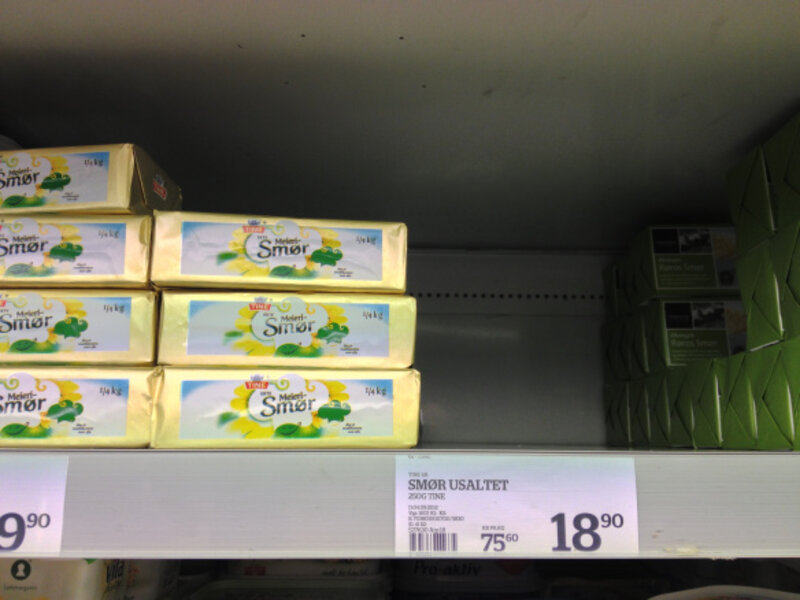Christmas without butter?! Norway's perpetually uncertain butter supply
Loading...
| Oslo
I've spent my first year in Norway trying to figure out what's wrong with this country. The work-to-life balance is ideal, the health care is great, and parental benefits are extravagant. It sounds utopian. But a recent trip to the grocery store revealed the darker side of Norway: there aren't enough cows.
Let me start from the beginning. I was supposed to bake a lovely cardamom bread for a recent potluck last weekend but I couldn’t find any unsalted butter. I went to three grocery stores and checked again throughout the week with no luck. There was regular butter and margarine in varying degrees of healthiness but nothing that I could bake with.
And now I’m getting nervous because last year there was a major butter shortage in Norway and I wonder if it’s going to happen again.
A butter crisis? It is such a strange concept. There’s rarely a shortage of any kind in the US. You walk into a store and you’ll find everything in abundance: aisles of ketchup, 20-packs of baby bibs stacked ceiling high, a 40-pack of toilet rolls. There’s no such thing as running out of the basics and there’s no such thing as buying just one.
I didn’t tell anyone back home about the butter famine because I was embarrassed that I had just moved to a place that, however modern or wealthy it was, couldn’t provide me with something so basic. Swapping homemade butter techniques was a normal conversation here last year. I couldn’t hide it for long because Stephen Colbert got wind of the story.
Mr. Colbert says the crisis was the result of a popular low-carb diet but that was an excuse a local dairy company tried out on the angry public. Actually it was because Norwegian farmers don’t have enough cows to meet local demands for dairy products and because of the government’s draconian protectionist policies that limit importing.
So there it is, the fly in the ointment: an extreme case of protectionism.
Protectionist policies in Norway include high import tariffs, import quotas and millions of dollars in subsidies for domestic farmers as incentives to continue production despite the difficult geographic and climate conditions so close to the Arctic. These policies are supposed to protect local products and the jobs they bring to the economy.
For example, to protect Norwegian cheese producers the government recently increased import taxes on foreign cheese by 277 percent. I guess I’ll be buying homegrown cheddar.
But perhaps Norway has taken it too far. In the case of butter, the government was naively trying to rely only on its own farmers, whose cows have more snow than grass to graze on. It could easily get it from neighboring Denmark (a major exporter of butter) but Norway’s trade barriers not only make that difficult, but they also raise the price of domestic products. So what does everyone do? During the butter crisis last year they did some crazy things – like buying butter in online auctions for four times the price.
Besides that Norwegians do what they call a harry tur, or “trash trip,” to Sweden for cheaper groceries. The two countries share a border yet Sweden’s more relaxed business environment means that items are generally 40 percent cheaper. A growing trend amongst my budget-smart friends in Oslo is to make the one hour and 40 minute drive to a shopping center in Strömstad, Sweden. Last year Norwegians spent 11.5 billion kroner ($2 billion) on the other side of the border, according to Statistics Norway.
Clearly, locals aren’t happy with some of the drawbacks of protectionism.
My post, Norway’s dirty secret, provoked an insightful discussion in the comments section about socialism in Norway and I hope that conversation continues. Of course there are downsides to living here but they pale in comparison to the benefits. I don’t mind finding things out of stock from time to time (even if the reason is absurd), if it helps keep unemployment at 3 percent.
I’d still like my own cow though.
The Christian Science Monitor has assembled a diverse group of the best family and parenting bloggers out there. Our contributing and guest bloggers are not employed or directed by the Monitor, and the views expressed are the bloggers' own, as is responsibility for the content of their blogs. Saleha Mohsin blogs at Edge of the Arctic.








